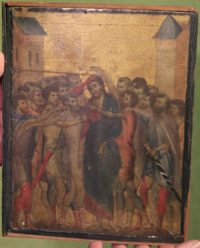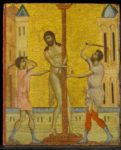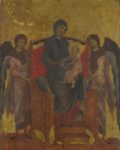 A painting that for years hung over a hotplate in a Compiegne kitchen has been identified as a 13th century tempera-on-panel by Cimabue. Its owner, a woman in her 90s, knew nothing about it. She thought it was a Russian religious icon and had no recollection of how or when she’d gotten it. Even though it had been perched over the hotplate for years, it was in good condition. When the elderly lady decided to move out and sell her 1960s home and its contents, she contacted a local auctioneer to see if there was anything worse selling. The appraiser had a week to go through the house before the owner sent everything to the dump.
A painting that for years hung over a hotplate in a Compiegne kitchen has been identified as a 13th century tempera-on-panel by Cimabue. Its owner, a woman in her 90s, knew nothing about it. She thought it was a Russian religious icon and had no recollection of how or when she’d gotten it. Even though it had been perched over the hotplate for years, it was in good condition. When the elderly lady decided to move out and sell her 1960s home and its contents, she contacted a local auctioneer to see if there was anything worse selling. The appraiser had a week to go through the house before the owner sent everything to the dump.
She noticed the painting over the hotplate right away and thought it might be something special, an Italian primitive piece worth several hundred thousand euros, at least. She suggested they get expert from Paris to assess it. Old Masters specialists from the Turquin gallery in Paris examined the painting in detail, including under infrared light, and determined that it is was painted by Cimabue.
“It’s a major discovery for the history of art,” Pinta said of the newly discovered work measuring about 10 inches by 8 inches (24 centimeters by 20 centimeters). Other experts agreed.
The Florentine painter Cenni di Pepo (c. 1240 – c. 1302), nicknamed Cimabue, was a pioneering artists of the late medieval period who introduced naturalistic emotion and perspective into the two-dimensional, heavily symbolic Byzantine painting style. In so doing, he and contemporaries like his student Giotto were key to the transition of the static, stylized painting of Middle Ages into the Italian Renaissance. There are only 11 known panel paintings by Cimabue and none of them are signed.
The newly discovered panel, Christ Mocked, depicts Jesus surrounded by a jeering mob after his trial before the Sanhedrin, an event described in all three Synoptic Gospels. It was originally part of a larger piece, perhaps an altarpiece diptych, that depicted several small scenes from Christ’s Passion and death. It was dismembered and sold off in individual lots, a sadly common fate for rare early panel paintings during the frenzied souvenir collecting of the Grand Tour era. Scholars believe that two other panels from the piece are now in the Frick Collection in New York and National Gallery, London.
 The Frick acquired its panel, The Flagellation of Christ, in 1950, but at the time it was loosely attributed only to the Tuscan school. It wasn’t confirmed as the work of the innovative medieval master until 2000 when the companion piece now in the National Gallery, The Virgin and Child with Two Angels, was rediscovered in the ancestral home of a Suffolk aristocrat and was accepted by the government in lieu of Inheritance Tax. The wood — type, carpentry and condition, down
The Frick acquired its panel, The Flagellation of Christ, in 1950, but at the time it was loosely attributed only to the Tuscan school. It wasn’t confirmed as the work of the innovative medieval master until 2000 when the companion piece now in the National Gallery, The Virgin and Child with Two Angels, was rediscovered in the ancestral home of a Suffolk aristocrat and was accepted by the government in lieu of Inheritance Tax. The wood — type, carpentry and condition, down  to the wormholes — and paint — material and style — comparison marked the two panels as having been painted at the same time by Cimabue.
to the wormholes — and paint — material and style — comparison marked the two panels as having been painted at the same time by Cimabue.
After examining the French kitchen find, Turquin gallery specialists concluded with “certitude” it bore hallmarks of Cimabue’s work, Pinta said.
They noted clear similarities with the two panels of Cimabue’s diptych, one displayed at the Frick Collection in New York and the other at the National Gallery in London.
Likenesses in the facial expressions and buildings the artist painted and the techniques used to convey light and distance specifically pointed to the small piece having been created by Cimabue’s hand.
The work will go under the hammer at the Acteon auction house in Senlis, north of Paris, on October 27. It is estimated to sell between four and six million euros ($4.3 million – $6.6 million), but the sky is the limit really. This is the first time a Cimabue has ever come up for auction and museums and collectors with the deepest pockets imaginable are going to be gunning for it.
Quite the Mickey Mouse sword…
(Ahem.) Pathetic earthlings, Spellcheck can’t save you now!
Tempura-on-panel:
https://en.wikipedia.org/wiki/Tempura#/media/File:Tempura.JPG
Tempera:
https://en.wikipedia.org/wiki/Tempera
Droopy stockings not a good look…
Well, it IS a “kitchen-find” after all…
Well Jim, Cimabue actually was one of the two earliest painters to attempt a more realistic style, he really had very few Masters to learn the style from.. I believe the Mickey Mouse sword you are referring to is still sheathed as the other two appear to be..